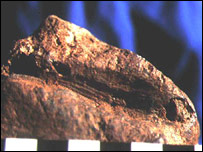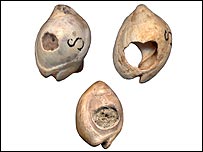Colorful beginnings of mankind.
A scientist working in Africa stated that the evidence found in Africa showed that humans knew how to use colors to symbolize perhaps some 200,000 years ago.
 That is Lawrence Barham scientist. He studied other tools and artifacts left by the ancient people in an area in Zambia.
That is Lawrence Barham scientist. He studied other tools and artifacts left by the ancient people in an area in Zambia.
He suggested that inorganic or ocher colors found in this region suggest that ancient people using paint might be able to draw symbols on the body.
This is an example of how people have abstract thinking and if this is true then when people have abstract thinking in an example discovered for the first time, they will have to back up at least 100,000. years ago.
Being able to create ideas in the brain - the ability to take this object to symbolize another - is a great leap forward in human evolution.
It is the thinking activity that allows people to develop complex mathematical language and skills later.
Language symbol
 The shells can be part of ancient chains and bracelets. (Photo: BBC) Researchers have long argued that shells are woven into necklaces or bracelets found in Irsael, the oldest and most evident evidence that demonstrates the ability to form ideas. thought in humans.
The shells can be part of ancient chains and bracelets. (Photo: BBC) Researchers have long argued that shells are woven into necklaces or bracelets found in Irsael, the oldest and most evident evidence that demonstrates the ability to form ideas. thought in humans.
But Dr. Barham, a researcher at the University of Liverpool, said it is difficult to accept that people do not have such thinking activities earlier than about 200,000 years ago in the industry literature. ancient
He said: "As an archaeologist, I am very interested in finding an answer to the question of where the human color symbol first appeared because the color icons are meaning it must be closely associated with language. "
"The ability to create icons of color is an abstract thinking activity so we cannot do abstract thinking," he told the Science Festival of the British Science Development Association. This statue has no language, so this is a language symbol on which we can find in archaeological documents the evidence for the emergence of language.
 Dr. Barham's work over the past 10 years focused on one area: Twin Rivers, an ancient cave chain in southern Zambia.
Dr. Barham's work over the past 10 years focused on one area: Twin Rivers, an ancient cave chain in southern Zambia.
People lived in those caves about 170,000-300,000 years ago but it is unclear what kind of people are. However, there is a bone in the cave of Heidelberg people (Homo heidelbergensis), the ancestor of modern humans, who are like us in big brains.
Ocher color
Dr. Barham said the devices discovered at Twin Rivers show evidence of increased thinking complexity with rudimentary stone axes replaced by sophisticated stone tools with handles. .
 Zambian ocher colors may have been used to paint on the skin. (Photo: BBC) The appearance of this " docking " technology coincides with the methodical use of earth colors. Ocher is a soft stone containing iron oxide; It has all kinds of different colors.
Zambian ocher colors may have been used to paint on the skin. (Photo: BBC) The appearance of this " docking " technology coincides with the methodical use of earth colors. Ocher is a soft stone containing iron oxide; It has all kinds of different colors.
In Twin Rivers area, there are all kinds of ocher colors red, yellow, brown, pink, black and even purple.
If these oats are scraped off, they will create a powder that can be mixed with animal fat and used like paint.
Dr. Barham is also wondering whether the ancient people in Zambia painted these pigments on their bodies in a special ceremony, in the same way that some cultures still use paint as today. Mark an older warrior or adult boy or girl.
The problem is that the paint made from ocher color and animal fat is also used in a very practical way such as preserving animal skin or making glue to attach stone axes to the rolls. hold.
Random creation.

Berekhat statue
(Photo: Don's Map)
Dr. Lawrence Barham said: "If you think these oxides are merely used in real life and have no symbolic value, then you have to explain why people are so Choose a variety of colors from these different places in Twin Rivers. "
"Because if the ancient people only chose lipstick to get iron elements, any color could be used - be it red or maybe yellow because any ocher color contains iron oxide. And some ocher colors are closer to ancient areas than other ocher colors, but they choose ocher in different places, so it seems that they purposely chose lipstick because of the color. That is just my argument. "
Previously, there were many arguments that people had abstract thoughts long ago hundreds of thousands of years ago. Most of these arguments are associated with rocks thought to portray human form.
For example, the stone statue of Berekhat Ram found in Israel and the Tan-Tan stone statue found in Morocco is believed to be the work of the Homo erectu type.
But other researchers suspect that these stone statues are only a product of the natural weathering process; They are objects that casually form the shape of a human through geological processes.
And Dr. Barham knew that he would have a way to convince his colleagues about his case.
He told BBC News: "Archaeologists are very careful. We set high standards for recognizing the interpretation based on the ability to form symbols in people."
The groove on the lipstick proved that the lipstick was removed from the lipstick.
- New technology allows solar cells to be more colorful
- The showy tail is not to attract mates
- The colorful beauty of China
- Where do we humans evolve?
- Beautiful architecture of the world's most colorful town
- Detecting strange colorful shrimp
- A colorful meal helps prevent cancer
- Discover strange colorful lizards in Peru
- Frogs are colorful in nature
- The most brilliant colorful birds in the world
- Birds lay colorful eggs
- Research gene turtle to treat cardiovascular disease
 Discovered an ancient centipede fossil 99 million years old
Discovered an ancient centipede fossil 99 million years old Discovered bat-like dinosaurs in China
Discovered bat-like dinosaurs in China Discovered a 200-year-old bronze cannon of the coast
Discovered a 200-year-old bronze cannon of the coast Discover 305 million-year-old spider fossils
Discover 305 million-year-old spider fossils Top 7 strange psychological effects of the brain that we all have without knowing
Top 7 strange psychological effects of the brain that we all have without knowing  We could start building a colony on Mars with just 22 people!
We could start building a colony on Mars with just 22 people!  CNN reveals a food that is a 'miracle drug' that helps people live to be 100 years old, and that Vietnamese people have been using for a long time.
CNN reveals a food that is a 'miracle drug' that helps people live to be 100 years old, and that Vietnamese people have been using for a long time.  Why are 76% of rich people introverts?
Why are 76% of rich people introverts?  13 extremely popular questions about the world that everyone is confident they know everything about, but are actually completely wrong.
13 extremely popular questions about the world that everyone is confident they know everything about, but are actually completely wrong.  Extremely interesting facts about the legend of bo bo during the subsidy period
Extremely interesting facts about the legend of bo bo during the subsidy period 